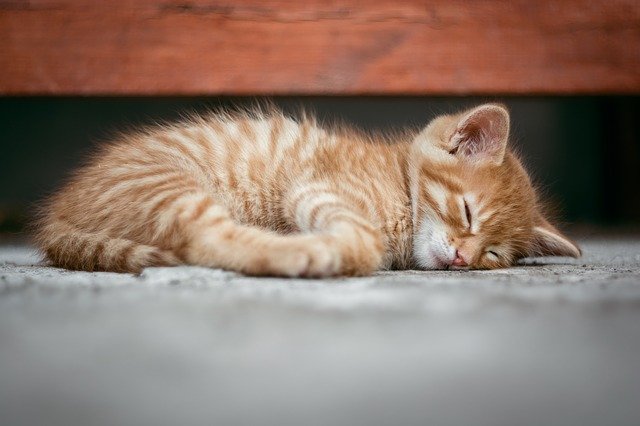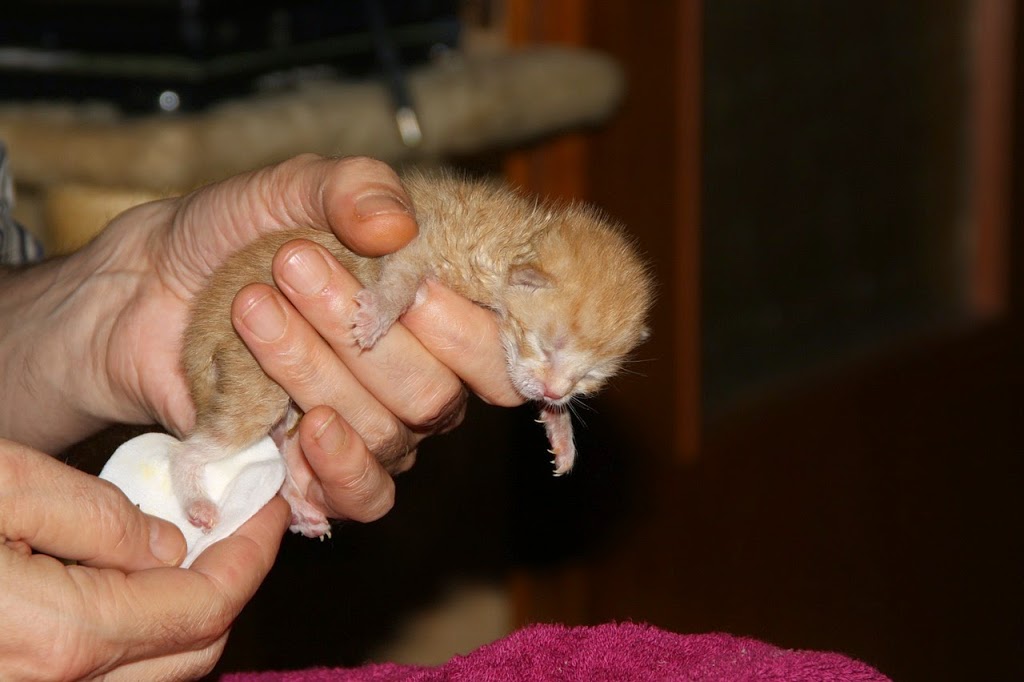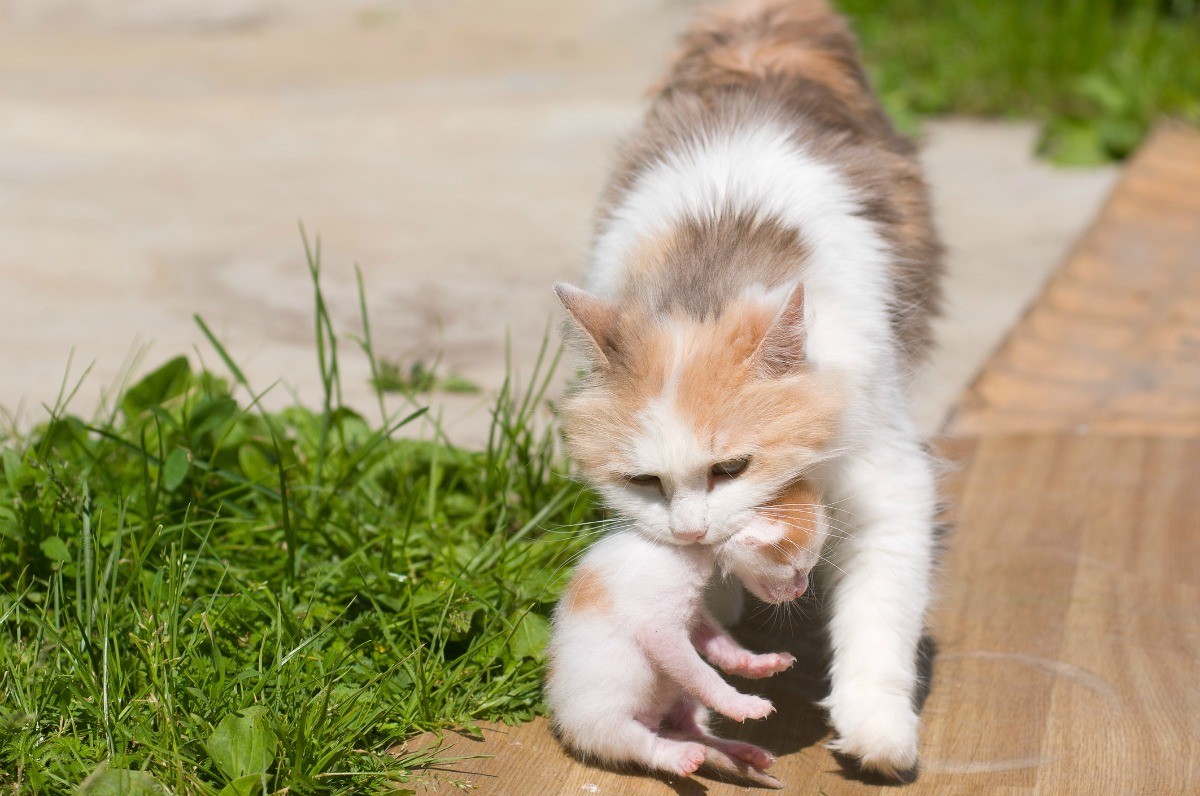After birth, kittens are designed to stay with their mothers until they are weaned.
The first month is especially crucial since this is the riskiest time of the young cat’s life.
For one, she is totally dependent on her mom for food and water. Secondly, her weak immune system puts her up for all sorts of infections.
A young kitten is also unable to control her body temperature and is predisposed to hypothermia.
We could go on and on but the bottom line is that newborn cats can easily die without being cared for by mommy.
However, mother cats die after giving birth. Others reject their young for one reason or another. It’s also common for a queen not to care for her litter as she should.
This is where you, as the human parent, come in. If you encounter a newborn kitten at the brink of death, don’t panic. There’s a whole lot you can do to save her.
How to Tell If a Newborn Kitten Is Dying

There’s a difference between an ill feline and one that is on her way out. The latter exhibits symptoms such as the following:
A. Hypothermia
One of the first tell-tale signs that a newborn kitty is nearing her deathbed is hypothermia.
This is where the body temperature drops below normal. It is hands down the biggest cause of death in neonatal kittens.
A kitten’s body isn’t ready to regulate its temperature at birth. Ideally, she should have a normal body temperature of 100-1020F.
If it drops below this, body function will begin to shut down eventually leading to death.
You can tell your cat is hypothermic if her extremities are too cold to touch. Touch her nose, tips of the ears, and tail.
Additionally, the pupil may become dilated and the kitty may have shallow breathing. She will also start to shiver, pant, and act lethargic.
B. Lethargy
Speaking of lethargy, a newborn kitten that is dying will have no strength to do anything.
She will have no drive to feed, play, or move a little.
Although newborn kittens don’t really move that much, they are eager to breastfeed.
If you rescue a baby cat that just wants to lie down for hours on end, take action immediately.
C. Vomiting and diarrhea
Vomiting in kittens is quite common. These creatures often feed too fast sometimes triggering their systems to spit back the food ingested.
They also throw up because of hairballs, poisoning, parasites, kidney disease, and diabetes.
However, a dying kitten will vomit too frequently. You may notice blood in his vomit.
Vomiting can also be accompanied by diarrhea.
D. Nursing challenges
Healthy kittens nurse well after birth. Despite being weak, they have enough strength to latch on and feed.
Dying kittens, on the other hand, are too weak and disinterested to bottle-feed or breastfeed. They oftentimes blatantly refuse to feed altogether. This is no good sign.
During the first three days of life, kittens should feed on colostrum heavily. This refers to the initial milk filled with antibodies and nutrients to help the kitten thrive.
If she doesn’t feed immediately after birth and a few days after, she may not make it unless she receives medical help.
E. Frequent crying and restlessness
A newborn kitten that cries too much and has a hard time staying calm may also be dying.
Pain and discomfort can overwhelm her to the point of being restless.
Often, she will show other dying signs along with crying and restlessness.
What Can You Do To Save A Dying Newborn Cat?

Watching a sweet kitten waste way has got to be one of the most heartbreaking scenes in the world. It tears your heart into a million pieces.
Fortunately, there are some actions you can take to save the animal. Follow these steps of success.
1. Keep the cat warm
As mentioned, hypothermia kills kittens more than anything else. Your first order of business when saving a dying kitten is to make sure she’s warm.
If you observe symptoms of hypothermia, get the kitten on a heating pad. A bottle with warm water also does the trick.
If both are nowhere near you, get a sock, fill it with rice and then place it in a microwave.
Now put the sock all over the kitten and hope for effective heat transfer to take place.
If the poor thing is doing really badly, grab her and place her on your bare chest.
For a kitten that is not already suffering from hypothermia, you can look for a warm spot to keep her.
Get a box that is neither too small nor too big for the kitten. Throw in soft bedding and place the kitten in there.
2. Feed the kitten
After your kitten is warm, the next thing to do is to feed her.
Besides a drop in temperature, kittens also pass away because of hypoglycemia or low blood sugar.
Like newborn kids, kittens need to feed frequently lest their blood sugar dips. They need to take in enough milk right after birth to ensure their levels remain steady and healthy.
Apart from a drop in blood sugar, lack of food in the kitten’s body can have adverse effects.
The body will essentially lack the necessary nutrients to supply to vital tissues and organs. As a result, organs will eventually shut down.
Look for kitten formula and manually feed it to the kitty. If mom is around, try any means possible to get her to nurse her young.
Most kitties will be too weak to nurse normally. You might have to use a spoon or syringe to get the milk down.
Related Post: How Much Water To Syringe Feed A Cat?
3. Look out for injuries
Healthy, warm, and well-fed kittens can also pass away as a result of over bleeding and infections.
For abandoned cats, injuries come in the form of road accidents, attacks from wild animals, and contact with sharp objects.
Indoor kittens sometimes get injured as they struggle to breastfeed.
No matter the cause, a kitten with a deep injury needs help before it’s too late.
Once she is warm, assess her body for any cuts. If you notice any bleeding, determine to close them as soon as possible.
Too much blood loss will trigger shock signified by low blood pressure and an increased heart rate. Ultimately, that will result in death.
According to VCA Hospitals, there are different strategies for controlling the bleeding.
The method used depends on the location of the injury.
- Feet: Bleeding signifies that a major blood vessel has been severed. To stop blood loss, wrap a clean towel around the wound and then apply steady but firm pressure. If the towel is soaked with blood, add another one and repeat the process.
- Paws: Lacerations to the paws are the least dangerous. You want to follow the same procedure as above. If the injury is a result of a broken nail, apply baking powder or flour to the wound. You may also stick a piece of bar soap on the tip of the nail to control bleeding.
- Chest or stomach: If your kitten has a cut on her torso, placing a towel and holding it in place may do more harm than good. Instead, secure the towel using about 4 strips of tape and ensure they encircle the abdominal areas. The tapes should be gentle lest they impair breathing.
4. CPR
Kittens that have reduced heartbeats or those that are not breathing well require CPR exercises.
If the poor thing is not breathing, chances are that she has debris in her airway.
Try the Heimlich maneuver if you are in a position to. Simply place your fist on the cat’s chest and gently press on it to get rid of the dislodged object.
If the maneuver is not working, puff gentle breathes through her nose in 20-second intervals until she breathes on her own.
Perform chest compressions if she doesn’t have a heartbeat.
5. Rush to the vet
Regardless of how experienced you are in caring for newborn kittens, there are certain things you cannot do to help a dying cat.
To be safe, dash to the emergency room. The kitten probably needs antibiotics, IV fluids, surgery, and more to save her life.
Closing Thoughts
Saving a newborn kitten from dying is scary and intimidating.
However, when you think about what can happen if you don’t offer help, the alternative route is better.
Whatever you do, don’t panic. Contact the vet as you carry out the aforementioned actions.
You could just rescue precious life!

Hi! I am Eleanor Price. I started this website after my cat, Louie, almost died from a case of botulism (a type of food poisoning often caused by bacteria that grow on food items). Turned out that my cat’s diet was the problem. I have made it my duty to provide the best information and recommendations about everything cat lovers need to know about their felines’ health and wellbeing. My goal is to find the most informative content on anything feline-related and share it with fellow hardworking kitty lovers.

